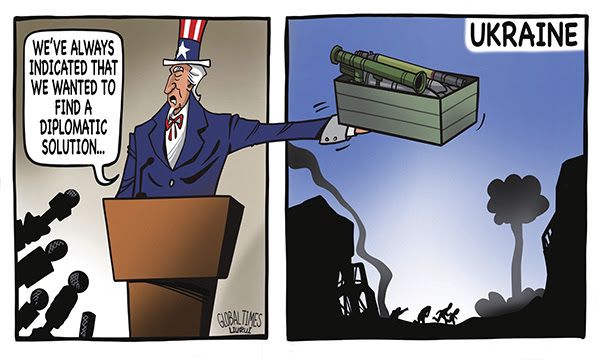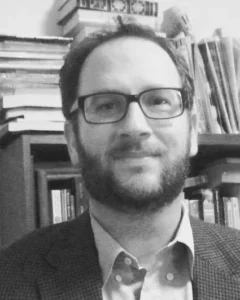Shedding Light on Who, Exactly, Is Responsible for the War in Ukraine
BALKANS AND EASTERN EUROPE, 8 Aug 2022
Roger Annis | CovertAction Magazine - TRANSCEND Media Service
6 Aug 2022 – On July 7, Fairness and Accuracy in Reporting (FAIR.org) published an article by Gregory Shupak analyzing the hypocrisy of U.S. corporate media in its reporting of Ukraine, specifically the differing treatment by Western media of the situations in Donbas compared to that of the Serbian-Albanian territory of Kosovo. The article was titled, “Media support ‘self-determination’ for U.S. allies, not enemies.”
Shupak writes, “My aim is to investigate whether there were significant differences in how corporate media covered the Kosovo [1999 and onward] and Donbas [2014 and onward] cases despite their similarities.” He details how there are, indeed, significant differences in the media coverage—whereas corporate media supported “self-determination” for Kosovo, they do not accord the same support to the people of Donbas.

It is an informative read. Even more so if it is read in tandem with an April 25, 2022, article by Dan Kovalik of the University of Pittsburgh School of Law, titled “Why Russia’s intervention in Ukraine is legal under international law.”
That said, Shupak’s article contains several inaccuracies and oversights that detract from its otherwise informative presentation. These are very important to understand, given the significance of Russia’s political/military intervention in Ukraine and the stakes in an eventual settlement.
Setting the record straight on “separatism” and who invaded whom in Donbas in 2014
Shupak writes, “Donetsk and Luhansk, the Donbas’ two major regions… have been war zones since 2014, when Russia-aligned separatists began fighting Ukraine’s central government after the success of the U.S.-backed overthrow of Ukraine’s elected government.” This is factually wrong on several accounts.
First, the claim of “separatism” directed against the rebel movement in Donbas is inaccurate. The Donbas republics agreed in February 2015 to the Minsk 2 peace settlement (text here). It envisioned a referendum on political autonomy that would, among many measures, more formally guarantee language rights for Russian speakers in Ukraine. Minsk 2 superseded earlier talks and agreement in the late summer of 2014 (also reached in Minsk, hence the term “Minsk 1”) which Shupak’s article describes.
Unfortunately, Shupak does not mention Minsk 2 in his article text. That highly important agreement was endorsed by no less than the Security Council, on February 17, 2015, unanimously to boot. Kyiv and the NATO powers that signed onto the agreement then proceeded to sabotage it during the seven years that followed.
Second, the conflict in Donbas commenced in April 2014 when the coup regime in Kyiv and its paramilitary, extreme-right battalions-in-formation invaded the two then-Ukrainian oblasts (provinces) of Donetsk and Luhansk. The two oblasts comprise the historic region of Donbas. Kyiv intended to violently suppress the pro-autonomy movements there.

Paramilitary forces-in-formation acted similarly against the people protesting in favor of autonomy in the city and oblast of Odessa. The rightists murdered as many as 50 pro-autonomy protesters on May 2, 2014, after protesters had taken shelter in the city’s massive, historic Trade Unions Building. The building was set on fire by the rightists and many of those who tried to escape the building were clubbed to death.

[Source: nbcnews.com]
An unjust intervention by Russia in Ukraine in 2022?
Shupak describes Russia’s military intervention in Ukraine is unjust. But unjust for whom? Certainly not for the people of Donbas. They have endured seven years of low-intensity war against them by Ukrainian armed forces and paramilitaries, with political support as well as military training and equipping by NATO countries.
That war cost some 14,000 lives on both sides (as of February 24, 2022), including more than 3,100 civilian deaths. Most of those deaths occurred on the Donbas side.
Today, it is necessary to understand not only what Russia is doing with its intervention in Ukraine but also what alternative existed to stop Ukrainian aggression against Donbas and to assure Russia’s national security. Recall that Ukraine and NATO were preparing in late 2021 and early 2022 for what they hoped would be a “final” military blow to aspirations for Donbas autonomy (now independence-from-Ukraine). Russia warned the world against this months earlier.

[Source: rferl.org]
It is eye-opening to read today the “Update on Ukraine” by Russian Foreign Ministry spokeswoman Maria Zakharova on December 1, 2021. (The full text of that briefing is appended at the end of this article.) She explained, “Kyiv’s efforts to subvert the Minsk agreements are most vividly on display at the contact line in Donbas. The Armed Forces of Ukraine (AFU) are building military power, and drawing up heavy equipment and personnel. According to some estimates, the strength of Ukraine’s armed group in the conflict zone is already close to 125,000. This is half of the AFU personnel.”
Adding to this threat was, and remains, the presence of NATO soldiers in Ukraine. In December 2021, the Zelensky regime in Kyiv adopted a special law to permit foreign soldiers onto its soil.
As an entry by the U.S. Library of Congress explains, “The adoption of this law was required because the Constitution of Ukraine prohibits the creation and operation of armed units in Ukraine if they are not authorized by national law.”
NATO has waged a decades-long drive to expand its country membership right up to the Russian border. NATO doctrine holds that an attack against one country-member is “an attack against all.”

[Source: politico.eu]
Whose diplomacy?
Shupak says a return to diplomacy is needed to settle the conflict in Ukraine. But Russia and the people of Donbas have exercised seven years of extreme patience in hoping and expecting that diplomacy in the form of Minsk 2 would be implemented. What is needed is real diplomacy, not a repeat of the sham diplomacy as we saw following Minsk 2.
Shupak disregards this dilemma over diplomacy. He leaves the false impression that Russia is to blame for the current failure to reach a diplomatic solution. He further compounds such a distorted view of events by failing to explain that, in the recent weeks, it is Ukraine that has refused to engage in diplomacy and negotiations. Far from being nudged by NATO members to engage in negotiations, Kyiv is being encouraged not to do so. The reason for this is, by now, public information—NATO is counselling Kyiv against negotiations because the two partners are recklessly (and hopelessly) pursuing military action in a bid to weaken Russia, a goal which leaders in Washington no longer even try to hide.
A proper humanitarian response to all this would be to call upon the aggressor powers to recognize Russia’s legitimate national security concerns and to negotiate peace with the people of Donbas. Negotiation is precisely what Kyiv and NATO–not Russia–are refusing to engage. Indeed, the photo caption of Shupak’s article in FAIR.org cites his own words in explaining: “Had the U.S. seriously pursued peace, Minsk II could have both ended the war in Donbas and extinguished the NATO issue that was a driving factor in the invasion Russia launched.” Precisely. And we can add today that little or nothing since has changed on this front.

Chris Hedges condemns NATO expansion but muddies the waters over Ukraine
Writer Chris Hedges has detailed in a new article the years and decades of aggressive, NATO expansion intended to weaken and humble Russia.
He explains that, following the demise of the Soviet Union in 1990-91, “NATO and the militarists had no intention of embracing [a] ‘peace dividend,’ fostering a world based on diplomacy, respect of spheres of influence and mutual cooperation. [NATO was instead] determined to stay in business. Its business is war. That meant expanding its war machine far beyond the border of Europe and engaging in ceaseless antagonism toward China and Russia…”

It is a powerful news article and commentary. But the reader will find in it descriptions of events that are unclear if not mistaken. Notably, Hedges writes, “NATO expansion and the 2014 U.S.-backed coup in Kyiv led Russia to first occupy Crimea, in eastern Ukraine, with its large ethnic Russian population, and then to invade all of Ukraine to thwart the country’s efforts to join NATO. The same dance of death is being played with China over Taiwan…” Here, in one sentence, we find three mistaken ideas or interpretations.
First, Russia did not “occupy” Crimea in early 2014. Following the violent and illegal coup in Kyiv in February 2014, Russia was immediately invited, indeed urged, by the elected and constitutional government of the Autonomous Republic of Crimea (Wikipedia) to protect the Crimean government and people from similar, violent coup actions as occurred in Kyiv and from threats of invasion (as Ukrainian far-right paramilitaries were commencing in Donbas).
Russia reacted positively and promptly, moving soldiers, sailors and police from Sevastopol into positions of defense and control. Those forces were already stationed in Sevastopol, Crimea, by virtue of the Russia-Ukraine “Partition Treaty on the Status and Conditions of the Black Sea Fleet” in 1997. (Wikipedia).

[Source: scmp.com]
It is important to understand here that, as a result of the coup in Kyiv, there was no constitutional government in power in Ukraine following February 2014. There was a constitutional government still in power in one region of the country–Crimea. It was the only region of Ukraine to have its own government. Its powers were similar to those of state governments in the U.S. or provincial governments in Canada.
Second, Russia has not “invaded all of Ukraine” in the year 2022. It has acted to defend the lives and right to political self-determination of those regions of Ukraine with high numbers of ethnic Russians and where residents are under military threat or attack by Ukraine armed forces and ultranationalist paramilitaries.
Russia is also defending its own national security from the direct threat that NATO membership for Ukraine would represent and that the current presence of NATO soldiers and weapons on Ukrainian territory currently represents.
Third, it is not a “dance of death” taking place in Ukraine. What is taking place is a life and death struggle for political self-determination by people in Donbas and elsewhere in Ukraine facing political violence and loss of political rights. Russia is defending the right of self-determination of these people and it is defending the security of its own people.

By Chris Hedges’ mistaken measure, self-determination struggles and wars of national liberation throughout the 20th century should also be termed “dances of death.” China’s long struggle for independence in 1949 comes to mind. So, too, the ‘people’s wars’ in Korea and Vietnam following World War Two which freed those countries from imperialist domination.

Yes, many people tragically died in the many national liberation conflicts during the 20th and 21st centuries. But the blame for this does not lie with those who resisted imperialist war and violence (and, tragically, continue to do so today in many cases). No, the blame lies with those who perpetrate such.
Similar off-the mark points of analysis by other writers can be found who, otherwise, present informative news and commentary on the conflict in Ukraine.
For example, another writer at FAIR.org, Joshua Cho, published a very informative analysis on July 21 titled, “Calling Putin ‘Hitler’ to smear diplomacy as [being] ‘appeasement’.’” But out of left field appears this sentence in the article: “Russia’s brutal invasion of Ukraine is a violation of international law, condemned by 141 out of 193 countries in a UN General Assembly vote.”

[Source: fair.org]
But Russia’s action in Ukraine can be accurately viewed as a legitimate act of national self-defense, as per the article by Dan Kovalik cited earlier in this article. Moreover, Ukraine and its backers among the Western countries were given ample warning of the need to pull back from their reckless course of militarism and NATO expansion.
Furthermore, Russia is acting in a ‘responsibility to protect’ capacity in Donbass and southern Ukraine. Its actions in this regard are light years removed from the self-declared ‘responsibility to protect’ doctrine which Western countries created and have used in recent decades to justify countless violent and bloody coups and political interventions against governments that dare to defy imperialist diktat.
Yes, a large majority of UN General Assembly member countries voted for a resolution on March 1 condemning Russia’s intervention in Ukraine. But three of the world’s five most populous countries, with more than one third of the world’s population, abstained on that vote (India, China, Pakistan), while a repeat of such a vote in today’s conditions would receive far fewer votes in favour because the world now understands much better the true history and stakes in the conflict in Ukraine compared to more than five months ago.
Writer and broadcaster Aaron Maté penned an article on his Substack media outlet on July 16 in which he wrote a blatantly false accusation against Russia: “By invading Ukraine rather than [emphasis added] exhausting all diplomatic solutions, Russia bears obvious responsibility for the crisis.” This is, quite simply, factually wrong, as this present article has explained above in its explanation of the demise of the Minsk 2 agreement.

[Source: soundcloud.org]
Difficult as this is to believe, considering the tidal wave of corporate media messaging saying the opposite, Russia is far from being the ‘imperialist’ country which so many on the political right and also on the political left accuse it of being.
That accusation does not stand the test of serious analysis. What’s more, its intervention in Ukraine qualifies as an anti-imperialist initiative. Russia’s actions in Ukraine and elsewhere in the world (for example, in Cuba) are creating space–economic, political and military–for the victims of imperialism to live, breathe and fight for a different world in which big power dominance and hegemony give way, kicking and screaming, to a world of cooperation among peoples and countries.
Surely, this is something worth understanding and to welcome? And to prompt asking: How can the people of the world draw inspiration and follow the examples of the self-determination struggles in Donbas and Crimea and the decisions of the Russian government to refuse to abide by imperialist diktat?
Appendix: Update on Ukraine
[This “Update on Ukraine,” delivered by Maria Zakharova, spokesperson for the Ministry of Foreign Affairs of the Russian Federation, was part of the broader, weekly briefing on December 1, 2021.]

We receive many questions with a request to comment on the situation in Ukraine.
We are seriously concerned over Kyiv’s efforts at dismantling the Minsk process, and its de facto refusal to try to settle peacefully the conflict in Donbas.
On November 29 of this year, President Volodymyr Zelensky submitted to the Verkhovna Rada a draft law to allow foreign armed units to come to Ukraine in 2022 for participation in multi-national exercises. This action directly contradicts Article 10 of the Minsk Package of Measures providing for the withdrawal of all foreign armed formations from Ukrainian territory.
The draft Ukrainian law “On the Principles of the State Policy of Transition Period” has not been removed from the agenda, either. I would like to recall that we have repeatedly said that the adoption of this document will mean Kiev’s withdrawal from the Minsk agreements. We do not see any other option. Instead of a special status and amnesty for the residents of Donbass, this document envisages forced Ukrainisation, screening of officials and the de facto complete “mopping up” of the territories in the east of Ukraine. Although President Zelensky said during the press marathon on November 26 of this year that this is “not a current issue,” everyone understands that a decision on its approval may be adopted any time.
Kiev’s efforts to subvert the Minsk agreements are most vividly on display at the contact line in Donbass. The Armed Forces of Ukraine (AFU) are building military power, and drawing up heavy equipment and personnel. According to some estimates, the strength of Ukraine’s armed group in the conflict zone is already close to 125,000. This is half of the AFU personnel.
According to the OSCE Special Monitoring Mission (SMM), violations of ceasefire are recorded along the entire contact line rather than merely locally. On some days in the past few weeks, the number of violations exceeded the maximums that the mission recorded before the additional measures on enhancing ceasefire entered in force on July 22, 2020.
Heavy weapons banned by the Minsk agreements are being used increasingly. We have spoken about this more than once. Civilians are the hardest hit by the shelling by the Ukrainian military. It is strange that this is not seen by human rights champions in the Western countries nor by observers and special rapporteurs assigned to international organizations. The absolute majority of destroyed houses and civilian facilities are located in Donbass districts. Where is the international human rights movement? Where are the champions of humanitarian law? What about articles in the leading Western media? The matter deals not just with one person who becomes a target of Western media campaigns. This is about the population of a region that has been suffering under the iniquity of the Kiev regime for many years. It is on the verge of a disaster. The Kiev regime is tightening its military power around this population and does not deem it necessary to conceal its real attitude to the Minsk agreements. What else should the Kiev regime do, how should it humiliate the residents of Donbass for the Western mainstream to turn its head to the residents of this region and start wondering what is really happening there?

[Source: indianaexpress.com]
A civil war is raging in Ukraine. The population is suffering and dying from military adventures (we will talk about this later today). In these conditions, it is impossible to understand the cynical approach of the NATO countries and of NATO as an association. They continue supplying Ukraine with arms and ammunition and sending their military instructors to it.
Recently, Western capitals have started making statements about their readiness to send troop contingents to Ukraine as well. London reported its intention to send up to 600 British military personnel to Ukraine. Rendering such assistance to the state where settlement is a remote prospect and the domestic conflict is far from being resolved, the West should understand that it automatically becomes an accomplice in the crimes against Ukrainian civilians.
Against this backdrop, the hysterical campaign in the media, unleashed by Kiev and its foreign patrons about Russia’s alleged preparations for an offensive is simply a sidetracking maneuver, a fake excuse for the further militarization of Ukrainian territory.
We urge the NATO countries to stop their provocations and encouragement of the Kiev regime’s militaristic plans and do all they can to encourage Kiev engage in direct dialogue with Donetsk and Luhansk with a view to finding a sustainable peaceful settlement of the Ukrainian domestic conflict in line with the Package of Measures endorsed by a UN Security Council resolution. [end this section of briefing]
______________________________________________
 Roger Annis is a retired aerospace worker and resident in Vancouver, Canada. He publishes the website and blog A Socialist In Canada. Roger can be reached at contact@socialistincanada.ca
Roger Annis is a retired aerospace worker and resident in Vancouver, Canada. He publishes the website and blog A Socialist In Canada. Roger can be reached at contact@socialistincanada.ca
Go to Original – covertactionmagazine.com
Tags: Eastern Europe, European Union, Hegemony, Imperialism, Military Industrial Media Complex, NATO, Nuclear war, Pentagon, Proxy War, Russia, US Military, US empire, USA, Ukraine, War Economy, Warfare, West
DISCLAIMER: The statements, views and opinions expressed in pieces republished here are solely those of the authors and do not necessarily represent those of TMS. In accordance with title 17 U.S.C. section 107, this material is distributed without profit to those who have expressed a prior interest in receiving the included information for research and educational purposes. TMS has no affiliation whatsoever with the originator of this article nor is TMS endorsed or sponsored by the originator. “GO TO ORIGINAL” links are provided as a convenience to our readers and allow for verification of authenticity. However, as originating pages are often updated by their originating host sites, the versions posted may not match the versions our readers view when clicking the “GO TO ORIGINAL” links. This site contains copyrighted material the use of which has not always been specifically authorized by the copyright owner. We are making such material available in our efforts to advance understanding of environmental, political, human rights, economic, democracy, scientific, and social justice issues, etc. We believe this constitutes a ‘fair use’ of any such copyrighted material as provided for in section 107 of the US Copyright Law. In accordance with Title 17 U.S.C. Section 107, the material on this site is distributed without profit to those who have expressed a prior interest in receiving the included information for research and educational purposes. For more information go to: http://www.law.cornell.edu/uscode/17/107.shtml. If you wish to use copyrighted material from this site for purposes of your own that go beyond ‘fair use’, you must obtain permission from the copyright owner.
Read more
Click here to go to the current weekly digest or pick another article:
BALKANS AND EASTERN EUROPE:


